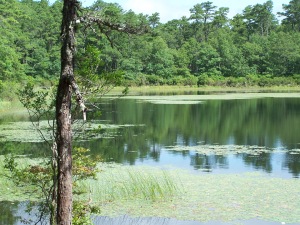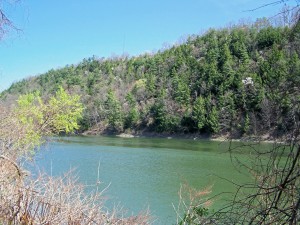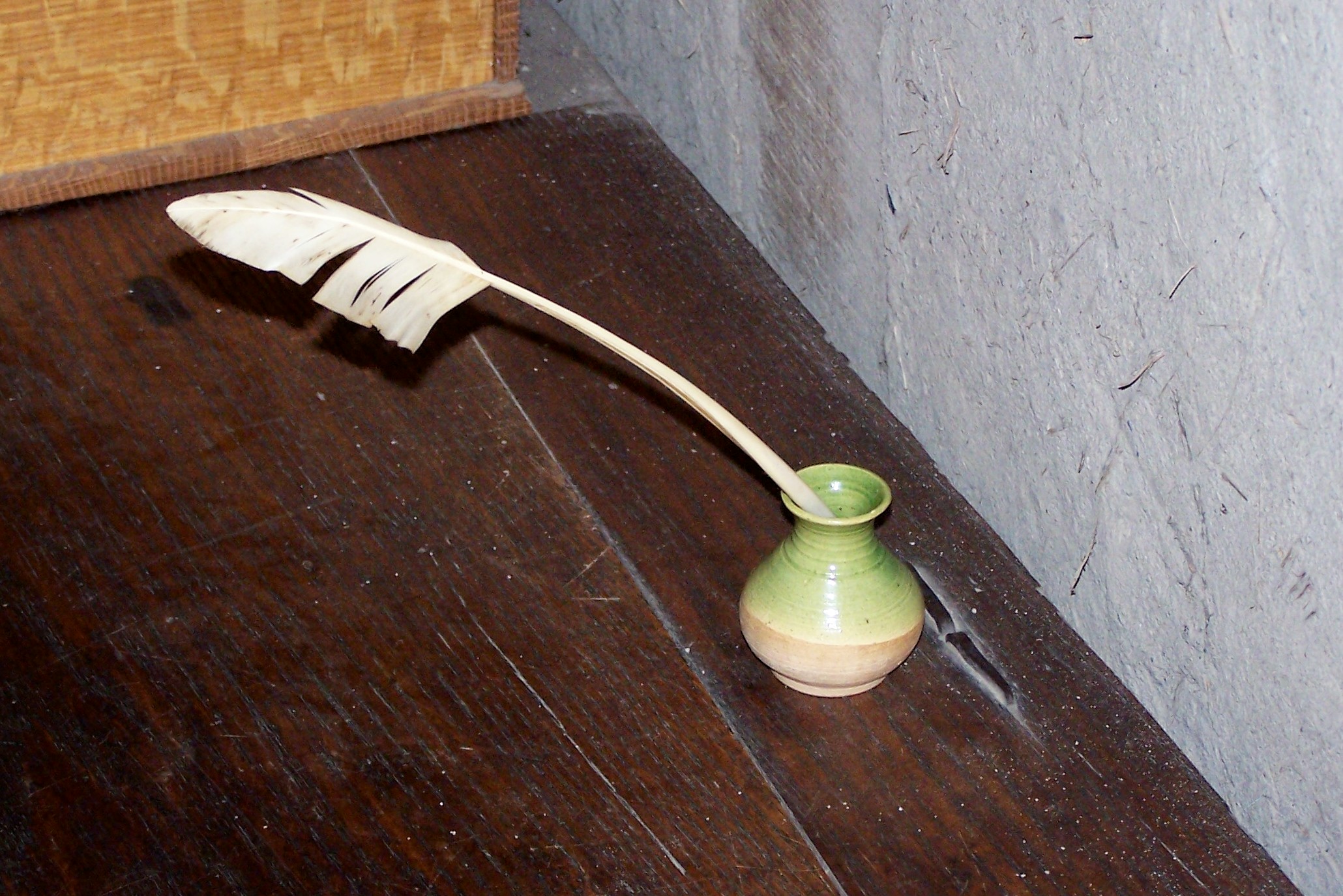Note: The following post is pretty long — a lot longer than I meant it to be when I started. But this category “Backyard Notes” won’t make much sense to anyone unless they have the background that this post provides. If it gets boring, just scan through it to get the general idea. Check out the links. There is some pretty interest material in them.

Last fall, my wife and I decided to make our property, especially our backyard, more hospitable to wildlife. The idea came to us while camping on Cape Cod, where we had been spending a lot of time noticing the natural world around us. Why should we make our own yard more like that?
I suppose there were a couple of ulterior motives running around below the surface for me. One part of making our yard more wildlife friendly, it seemed obvious to us, was that we shouldn’t mow as much of it. It wasn’t exactly an unhappy idea to me that we should cut back on the amount of time and energy I would be putting into keeping the grass short. All the more so, since the part of our back yard that we wouldn’t mow, we decided, would be the part of the yard that was always the most difficult to mow — the part that involved going in and out under low hanging branches and around little bushes.
The other element that our project would involve was the elimination of lawn chemicals. We had mostly been rather fitful users of lawn chemicals. Every couple of years I would apply one of the standard “weed and feeds” in the spring. And for a couple of years running we had applied grub killer in spring and late summer. Our neighborhood had always been a grub hotspot, at least so the local wisdom went. We, certainly, had a recognizable grub infestation.
We also were regular users of slug killing pellets. But that was much more a problem for us in our previous home in Columbus, Ohio. The bio-diversity of slug species there was inspiring. . .or would have been if slugs were not so innately revolting. The top of the heap were the Great Grey Garden Slugs, measuring sometimes as much as 5.5″ or even 6″ long.
Here in south-central New York I’ve only seen the small varieties. But in the past several years when I have seen slug damage on some of the plants that we’ve been trying to grow in our flower beds or in our vegetable garden, I have whipped out the slug poison quick as a gunslinger.
For a number of years, my favorite lawn poison has let me play gunslinger–hand-sprayed, spot weed killer has been my handgun of choice. My neighbors would often see me patrolling the lawns, hand gun at the ready. They pow, bulls-eye. And I could image the dandelion groaning and wilting over. Usually, it took a day or so for the victim to show signs of being shot.
Yet in the back of my mind with every application of some sort of lawn pois0n, I knew that some of it was going

to run off into the storm sewers. And the storm sewers went straight into the Chemung River, not two hundred yards away from my lawn. Twenty-five miles, give or take, the Chemung River flows into the Susquehanna River. A few hundred miles beyond that the Susquehanna flows into the Chesapeake Bay. Between the beginnings of the smallest woodland rills that arise somewhere in the hills of central New York and the shorelines of Virginia and Maryland there are hundreds of of thousands of lawns, farm lands, and golf courses. Tons upon tons of chemicals to fertilize the desired plants and kill the undesired ones and the insects are poured out on the the ground. There they gradually run off, leech out, and drain into the ever broadening funnels of runs, storm sewers, creeks, and rivers until they concentrate together at the mouth of the wide Susquehanna and flush into the Chesapeake Bay and the ocean beyond.
All along the way the particular effects of the chemicals varies depending on what sort of compounds predominate at any given place and moment. The fertilizers spark radical algae blooms that deoxygenate the water and clog the water ways. The various insecticides stunt, deform, or kill insects and other animals along the way. And I haven’t even mentioned the industrial pollution of the waterways or the parking lot and roadway crud that washes in via the storm sewers.
Well, anyway, these concerns about the environmental effects of what we did on our lawn nagged at me. Of course, the few pounds of chemicals that I spread will not by themselves destroy the environment, but I am part of the larger problem. The problem arose gradually over time. I’m pretty sure that my great-grandfather didn’t spread much in the way of chemicals on his lawn. I suspect he spread nothing at all. But over the past few generations attitudes about lawns and gardens have changed. Now, the use of lawn chemicals is very widespread in urban and suburban environments.
We Americans have, mostly unthinkingly, bought into the notion that the very best kind of landscape to wrap around a house or other building in a city or suburb is a rigidly controlled monoculture called a lawn. A monoculture in this case is an environment occupied by only one kind of organism. I call the ideal American lawn a monoculture because that is the prevailing attitude as to what a lawn should be. It should contain grass and nothing else. This grass must be cropped short and must not, under any circumstances be allowed to go to seed.
Further, there is a limited array of grasses that are acceptable for use in lawns — mostly blue grasses and fescues. There are thousands of species of grasses. Most are for one reason or another unacceptable as lawn grass in the ideal American lawn. Because of this, not only must the diligent American homeowner spread herbicides for killing broad leaf weeds, which are as pimples on the face of the ideal American lawn, but also the diligent homeowner must also spread herbicides that will suppress the growth of undesirable grasses.
Enormous amounts of energy and resources are expended by American to try to create the ideal lawn. According to Ted Steinberg, a professor at Case Western Reserve University in Cleveland, the lawn care industry as a whole in the United States is about a $40 billion a year industry. That is, he points out, about equal to the entire Gross Domestic Product of the country of Vietnam. What do we actually gain from all those resources, not to mention the person time and effort we may expend on the work ourselves? We get something that we think looks pleasing.
Well, last fall, Meg and I asked the question, “Is that worth the expense, time, effort, and pollution?” And we decided that it was not. But beyond this simple question, what tipped the decision for us was that desire, I mentioned at the beginning of this post, to make our yard more hospitable to wildlife. However pleasing the ideal American lawn might look to our eyes, to the eyes of the wildlife which shares our urban and suburban spaces with us the ideal American lawn looks like essentially barren ground.
Let’s take songbirds as a example. Our diligent application of herbicides (weed killers) means that we eradicate one of the key sources of seeds that songbirds need for food. In addition, our once or twice a week mowing ensures that the grass that is all that is left will also never produce any seeds. The short grass provides no cover for the birds, another necessary element for a hospitable environment for birds.
It is true that not all birds eat seeds. Some eat insects. But we American homeowners are suspicious of all insects and ruthlessly hostile toward many. Consequently, we think nothing of spreading a lethal dose of insecticide to our lawns once or twice a year. We only mean to kill the grubs and a few other harmful (to our lawn) insects. But the insecticides are not so selective. Noxious, innocuous, and even highly beneficial insects — all die.
I was so pleased this summer. On two occasions I saw a firefly (lightning bug) in my yard. One on each occasion. When I was a child (admittedly a very long time ago) suburban yards were alive with twinkling yellow lights. We could capture a pickle jar full of them, and watch them flashing on and off in one confined place for a while, then open the lid and watch them in twos and threes find their way out to freedom again. My children have never done that, all because I and my neighbors have crusaded vigilantly against grubs. Unfortunately, fireflies live their life cycle out in lawns also. And when the grub killer is spread, it kills the fireflies, too. Grub killer is also firefly killer.
The irony of that sad fact is that fireflies, primarily in their larval form, are predatory. What do they prey on? Slugs, garden snails, and possibly grubs!
The ideal American lawn — no seeds, no bugs, no cover. It became plainly clear to me that I could continue to strive for the ideal American lawn, or I could make my yard hospitable to wildlife, but I could not do both. So, good-by ideal American lawn.
We’ve reduced our front lawn to about one half to two-thirds of the space available. We accomplished that by enlarging our existing flower bed and by installing a 100 sq. foot raise vegetable garden. Who says gardens can’t be in the front yard. And no, we didn’t lose any produce to theft. In other neighborhoods that might not work out so well. We have spread no chemicals of any kind on the lawn. Yes, there are weeds in the lawn along with the grass, but it’s green and covers the bare ground. It looks quite fine to me. We do mow the grass, but with the large flower beds, hedge, and other shrubs and trees, there is plenty of cover for birds and other wildlife. In the backyard we’ve made much more extensive changes, but I think I’ll leave that story for another post.
Over the past year, as I’ve thought about what we’ve been doing in our yard, I’ve come to realize that this process has been much more than simply a different way of tending our yard. It’s been a small counter culture step–a decision not to buy into a prevailing attitude that is expensive, time-consuming, and destructive to the world I’m trying to live in, depleting it of much of what makes it rich and beautiful.
© 2009 Gary A. Chorpenning

I don’t know If I said it already but …Cool site, love the info. I do a lot of research online on a daily basis and for the most part, people lack substance but, I just wanted to make a quick comment to say I’m glad I found your blog. Thanks, 🙂
A definite great read..Jim Bean
LikeLike
Gary – saw your update on LinkedIn and clicked on your blog – I didn’t even know you were blogging! Best of luck in the green lawn pursuits – there is (obviously) a lot of information on the web about integrated pest management (the ladybugs eat the aphids sort of thing), as well as organic lawn maintenance. e.g. you should be putting corn gluten meal on your lawn now – all natural, fertilizes the lawn without the nitrate run off, and kills those dandelions without the chemical poisons. It takes a bit of research and maybe a trip to the garden store that’s not one of the big boxes, but you can do it! Good for you, steward of the Earth! And now that I’m reading, we must hear about whether the froggie comes back after his hibernation.
LikeLike
Awesome site I loved reading your info
birthday party supplies
LikeLike
I don’t usually reply to posts but I will in this case.
my God, i thought you were going to chip in with some decisive insght at the end there, not leave it
with ‘we leave it to you to decide’.
LikeLike